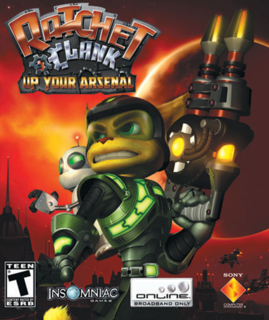"Qwarktastic!"
Much of the gameplay remains unchanged from Going Commando. The controls are tight and responsive; strafing and bounding around the place while blasting away at droves of enemies is still has frantic and fun as ever. The RPG-like process of leveling up and gaining “Nanotech” is back, and this time your health is displayed in a more straightforward numeral system than the icon-based health bars of past games. As always, a plethora of new weapons has been added to the roster, and given the fact that each weapon can be leveled up and upgraded 10 times, there is PLENTY of fun stuff to experiment with here.
Well, aesthetic tweaks and new weapons are pretty much a given when it comes to new Ratchet games. But some of the best improvements to be had here are some details that are so small they weren’t even that noteworthy in previous games, and many would hardly have considered them as needing sprucing up in the first place. For example, you now have 2 “quick select” pallets to assign and choose weapons from, accessible by tapping the triangle button. While it sounds like such a minor thing, you’d be amazed at how much convenience this brings to the weapon selection process, thus leaving the action uninterrupted by having to periodically choose an obscure gadget from your menus. In addition, you are now able to cycle quickly through the last 3 weapons you used, keeping the firefights even more fast-paced.
More significant changes to the gameplay include the absence of the somewhat drawn-out space battles in lieu of ground and air vehicle combat. Throughout the game, you’ll have the option of aiding the Galactic Rangers in military-based missions wherein you must drive back invading Thyrrinoids from whatever planet they happen to be devastating. While many of these missions simply have you fending off hoards of attacking aliens as they try to invade your base, after you gain the upper hand and begin to drive them back in subsequent offensive missions, you’ll often take to the skies in hovering aircraft outfitted with laser weapons, or attack them more directly in buggy-like ground vehicles. While these missions are entirely optional for the most part, they add a great deal of playtime to the game and are some of the most entertaining missions of the lot.
Another new addition to UYA is online and offline multiplayer. Players choose from a few different characters and try to take control of the maps by capturing nodes located throughout the battlefield, similar to games like Battlefield 1942 and Star Wars Battlefront. The aforementioned vehicles can also be used in multiplayer, although one’s inability to take certain vehicles anywhere, say, a dropship into an underground cavern, makes it feel somewhat limited. A fine play mode nonetheless, but Halo 2 it isn’t.
One more interesting addition is he Captain Qwark “vid-comic” series, each installment of which is unlocked as you progress through the game. These comics are represented as sidescrolling platforming stages featuring the bumbling superhero Captain Qwark, as controlled by Ratchet as he games his way through each chapter. These nostalgic old-school sequences are among the highlights of this game, and they themselves are worth a couple of playthroughs.
Frontend and gameplay enhancements aside, easily one of the best aspects of UYA is it’s story. Now, Captain Qwark’s “Q-Force” doesn’t exactly make for an epic saga, but this is easily of the funniest stories I’ve ever seen put to a game. Never before has a game made me laugh out loud so many times purely with well-delivered jokes, not just from cleverly written dialogue and superb voice acting, (the banter between archvillain Dr. Nefarious and his cuttingly sarcastic butler Lawrence is some of the best stuff in here) but also through ingenious storyboarding and well timed music and sound effects. (The comic book-like sequences in the Captain Qwark vid comic are another highlight of this game.) UYA’s humour is also a fine mix of slapstick silliness and references that for the most part stay within the realm of dodgy but now and again cross the line right into risqué, but nonetheless there’s nothing here that should be reserved for the 17-and-up crowd.
The Ratchet and Clank games in general are one of the PS2’s greatest assets, and some of the best examples of platforming perfection you’ll find on any current-gen system, though I would strongly recommend newcomers to the series to start from the beginning. In any case, Up Your Arsenal is easily the best entry in the series, thanks not only to it’s polished gameplay but also it’s genuinely funny script and superb presentation. A definite must-buy.

